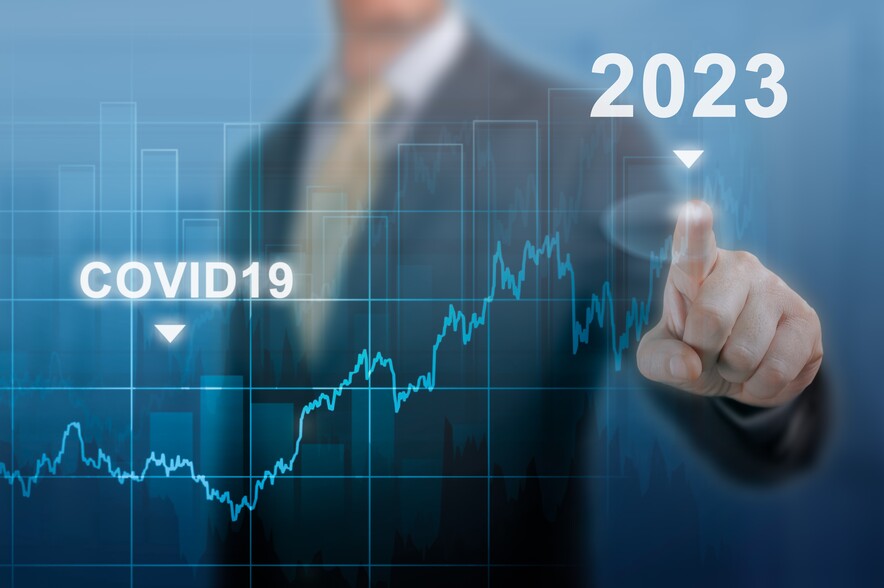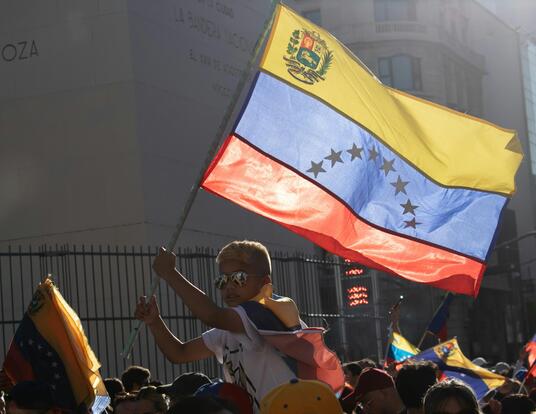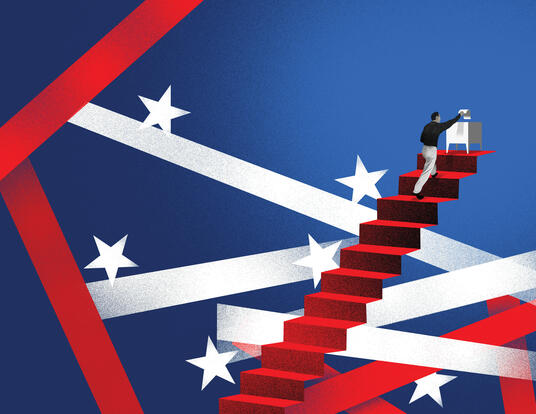Colloquy Podcast: What We Learned from the COVID Economy

The US economy is strong. Unemployment is close to a 50-year low, real wages are rising for those at the bottom of the income ladder, and inflation is down though still not entirely in the rearview mirror. You’d never know it from the press coverage, though, which tends to focus on how people feel about the economy, namely that it’s bad and getting worse.

In this episode of Colloquy, we take a step back from perception to look at where we were, where we are, and how we got here. What did the pandemic shocks teach us about government intervention in the economy? What did they show us about inflation and unemployment? And what have economists learned that can help policymakers cope with the next big crisis?
With us to parse these questions is Karen Dynan, a professor of the practice at the Harvard University Department of Economics and the Harvard Kennedy School. A senior fellow at the Peterson Institute for International Economics, Professor Dynan is the chair of the American Economic Association Committee on Economic Statistics. She previously served as assistant secretary for economic policy and chief economist at the U.S. Department of the Treasury from 2014 to 2017. She received her PhD in economics from Harvard Griffin GSAS in 1992.
This month on Colloquy: What we learned from the COVID economy.
This transcript has been edited for clarity and correctness.
Let’s go back to the spring of 2020. Describe what was happening with the economy as the COVID-19 pandemic spread throughout the U.S.
What we saw then was a shock to the economy that initially looked like it might be more severe than what we had seen in the Great Recession. We saw the unemployment rate spike up to 15 percent. We saw job loss in April 2020 that was about twice as big as peak job loss was after the Great Recession. And so there were real fears about what was going to come out of this period. Were we going to see these persistent scars even after the virus was behind us, whereby the macroeconomy never got back to its previous trend and we had periods of long-term unemployment? We had people still in bad shape financially years later.
Both the Trump and Biden administrations enacted major legislation to address the economic fallout of the pandemic. First, there was the CARES Act and then there was the American Rescue Plan. How much did government intervention have to do with the economy snapping back? And also, to what extent do you think it mitigated suffering during the downturn?
I think the vigorous fiscal policy response that was put in place after and during the pandemic played a really important role in the better economic outcomes that we saw. There were four major components of these fiscal support packages. The first was more generous unemployment insurance. We raised the amount that people who had lost their jobs were getting so that their incomes were supported even though there had been this massive job loss.
We also expanded the pool of people who could get unemployment insurance. So, typically, for example, someone who’s self-employed can’t get unemployment insurance because the government has a hard time seeing what actually is unemployment for that person. So that was a big deal. A second component was the support we gave to small businesses. And I think in a pandemic you have to particularly worry about small businesses because people aren’t out there going to restaurants and shopping locally.
And those are sectors in which small businesses are overrepresented. So we had a program through which we gave loans to small businesses, but if the small businesses used those loans to keep their operations running—and pay no wages to their employees—then those loans turned into grants. A third component was more aid to states and localities. They were on the front lines of fighting the pandemic so they needed that aid.
And then, finally, we had these direct payments to households. Sometimes they’re called COVID checks. You probably may remember getting one yourself that kind of went out to people both that kind of filled the cracks that weren’t covered by other programs, but also to support demand, generally, so that businesses could be confident that demand would be there once the pandemic was over.
But all these steps seemed to make a big difference for people in terms of basically allowing them to come out of this period of massive job loss with healthy finances so that they were ready to start to spend again.
I think I was reading just the other day that there was also a big drop in child poverty during those years as well.
Yeah. We saw all sorts of outcomes that were unusual for a period when the economy is disrupted and, in particular, they were unusual in the sense that people lower in the income distribution did well. So poverty actually declined. Child poverty declined. That’s partly because of the programs I talked about. But also we instituted a child tax credit that made a difference there.
How did different folks in different income strata experience the pandemic? And how’s the economy been working for them since the pandemic?
The job loss and the kind of work disruptions—they were really kind of more concentrated in sectors where people have to be in close contact with each other to basically engage in that business. So if you think about restaurants, you think about travel, hotels, and those sorts of high-contact services for which businesses tend to employ more people who are lower in the income distribution.
So we saw more job loss for that group. But because of government support, we also saw a lot of income replaced for that group. And, in fact, some people’s income was even higher than it had been before the pandemic. I will say that in the upper part of the income distribution, people mostly did well. We had this kind of remarkable shift to remote work, and people like you and me in the knowledge economy did pretty well without much disruption in terms of the period since the pandemic.
There’s a broader conversation that we should have about the inflation we’ve seen. But I can say that the strong labor market, just as we saw in late 2010, was a strong labor market, has benefited people in the lower part of the income distribution. We’ve had very strong demand for workers in the services sector. In fact, a worker shortage down there. And, as a result, we’ve seen their wages rise briskly.
We saw all sorts of outcomes that were unusual for a period in which the economy is disrupted and, in particular, they were unusual in the sense that people lower in the income distribution did well . . . poverty actually declined. Child poverty declined.
Is there any evidence that the relief people got during the pandemic made them somehow less likely to go back to work?
First of all, we should remember that in some cases we want people to be able to have that choice. If there’s someone who is particularly vulnerable to the virus, even after people are vaccinated, we want them to have the resources such that they have a choice. They don’t necessarily have to go back to work. And that could be someone who’s vulnerable themselves or someone who’s living with someone who is elderly and is very vulnerable.
I have not seen very compelling evidence that, for example, more generous unemployment insurance kept people out of the labor market. People have looked across states that ended their programs at different times. People have looked at what happened around the period when the national supplements faded out. And we really didn’t see discrete changes in the labor market around those events.
So I haven’t seen that compelling evidence. I will say it did take people who had lost their jobs a while to get back into new jobs. And I don’t think we quite understand everything that was going on there. But I will say that’s somewhat typical. And, again, it can be good if people wait a bit to find a job that is a better match for their skill sets.
What does labor market participation look like now, particularly for people in their prime working years (25 to 54)?
For that group, it’s come back to its pre-pandemic level. In fact, it’s now even higher than it was prior to the pandemic. And this is always one of the benefits that people talk about of a strong labor market, which is you have some people on the sidelines who are on the sidelines because they have some reservations about work conditions, or the jobs just aren’t attractive enough for them. Employers are not compromising enough around work-family balance and so on. When you get into a strong labor market, then you see employers making a much bigger effort to attract workers into jobs. And I suspect that that is part of what’s going on. But, you know, that’s just a benefit of having a strong labor demand, which is you see people who are not participating in the labor force before deciding to come back in.
Let’s talk about inflation now as a good segue to that. Is there any evidence that the primary driver of inflation, first of all, has been the increases in wages due to a shortage of labor in the market?
I think the jury is out as to what are the factors that have been feeding into inflation dynamics over the last couple of years. In fact, if anyone came to you and told you, oh, I know exactly how inflation works and where it’s going to go from here, I wouldn’t believe them. I was just out at the Fed’s Jackson Hole Symposium a few weeks ago and it was just a running theme among the central bankers there that we need to have humility. If there’s anything that we have learned from the last couple of years, we really don’t understand everything that drove inflation up. And so we don’t understand everything that’s going to be relevant for where inflation goes over the next couple of years. And I think that sort of humility is very appropriate.
I take to heart your remarks about humility, but now that we’ve had at least some chance to look at the data, what’s emerging?
It’s complicated, as best as I can tell. It’s been a story of an imbalance between demand and supply, which sounds very basic. But let me explain further. So, early on, I think this transitory story was the one that central bankers and others were very fixated on. I think what they were missing was that demand was really strong coming out of the pandemic. There had been this kind of period where people hadn’t done as much consumption of goods and services, I mean, mostly services as they usually did. So there was this kind of pent-up demand. And because people had saved during the pandemic, partly due to this generous fiscal support, people really had the wherewithal to finance this pent-up demand.
So we had this kind of strong underlying demand, which has persisted. And then on the supply side, the productive capacity of the economy just couldn’t ramp up fast enough. And I think part of the mistake early on with the transitory story was that people were fixated on what has turned out to be just quirky temporary stories. So we all remember—in fact, I love to show this picture of the ships all stacked up outside the ports in L.A. It’s such a dramatic picture, but it really kind of captures this bottleneck that we had in the summer of 2021. There was a similar kind of quirky story around used cars being in short supply.
And I think on the supply side, the mistake has been not recognizing the scope for further shocks, but also not recognizing some bigger broader shocks. And I think in the former category, you know, we saw the invasion of Ukraine, which led to a spike in energy and food prices. We saw these rolling shutdowns because of COVID-19 in China, which led to further supply chain problems.
But then we saw these broader things like the worker shortage. That’s a supply constraint. And I would say we also effectively have had a shortage of housing. So I think we had both kind of a stronger demand and kind of just broader things happening on the supply side than we initially recognized.
What did the pandemic shocks and the inflation that followed teach us about monetary policy?
I think because of the misunderstanding of the sources of the pick-up in inflation in 2021, the Fed and other central banks were late to the game when it came to raising interest rates. I think we knew by the fall—certainly, the late fall of 2021—that it looked like inflation was broader and less transitory than we initially thought it was going to be.
We didn’t see the Fed start raising its policy rate until March 2022, and then it kind of went slowly at first. Now, I should say the Fed and other central banks have since made up for that initial misjudgment. They have raised rates quite aggressively in an effort to tame inflation. I think they were kind of in the wrong place at the beginning, but they have gotten to the right place.
The organizing principle of our conversation today is to step away from all of the coverage about people’s perceptions of the economy. But I do want to take just a second here. I guess USA Today did yet another recent poll of how consumers were feeling about the economy, and something like 85 percent of the respondents said that it was, you know, either not very good or getting worse. Putting aside the impact of partisan polarization, do you have a take on what’s going on in people’s psychology?
One lesson from the last couple of years is that people hate inflation. And I think we don’t fully understand what’s going on there. For a long time we kind of said, oh, it doesn’t really matter if inflation’s 2 percent or 3 percent or 4 percent. You know, those costs are pretty low. But over the past couple of years, we have just seen people really feeling like the entire economy is doing poorly because inflation is high.
I think partly it is the uncertainty around inflation that makes a difference. You know, if you’re on a pretty tight budget and you’re paying for gas to get to work, for example, I mean, you don’t really know where gas prices are going. That’s going to be a stress on your family if gas prices are high.
You might have a really kind of lean couple of weeks just to get to your job, just to get to work. So I think people get stressed by the uncertainty around inflation. We should not overlook the partisan divide. The other thing that I think we’ve seen happen, and I would say this is this phenomenon of the last decade or so is that people really do seem to have their attitudes shaped by the attitudes of their leaders.
And so when a leader comes out and says, oh, immigration is terrible and it’s causing terrible things in our economy and terrible things for your family, we see people who for years have supported immigration change their view. I think, you know, we should pay some attention to this partisan divide because I think it has real consequences for the economy if people have come to the point where their expectations about where their income is going to be heading in the future are just kind of unduly shaped by what they’re hearing from their leaders.
Is there some evidence that corporations or at least some big businesses rode the wave of inflation and said "We can just lump this in with the general price increase folks are seeing and blame it on that," even though their costs weren’t really rising so much?
My own view is that firms are always looking to raise prices. This is what they’re doing. What they do is they try to earn profits for their owners. Right. And, you know, the question is what empowers them to raise prices? And there I do think we should be looking at, well, you know, when demand is strong, that empowers them to raise prices.
The other story that I think you were hinting at is a little more fuzzy. And I think we don’t have evidence on it, whether there’s just confusion about appropriate prices is that you know, that firms kind of took advantage of it and said they were able to kind of, you know, when the inflation is just 2 percent and 2 percent year after year after year, you’re really going to notice if someone raises prices by 3 percent.
But when prices of different goods are all doing different things, does that give you more power to price? So I don’t know the answer, but I think it needs more study. As best as I can tell from people who have looked at kind of corporate profit shares, they have found that profits are high, but they haven’t been particularly high in this period of inflation. It doesn’t look like the patterns map that closely into the sectors in which we’ve seen more and less inflation.
[Labor market participation has] come back to its pre-pandemic level. In fact, it’s now even higher than it was prior to the pandemic.
The last time I guess that the US economy was experiencing high inflation was in the late seventies into the early eighties. The Federal Reserve under Paul Volcker, I mean, really hit it over the head with a club a bunch of times. It raised rates really aggressively and sure enough, prices did eventually cool down. But the country dropped into a pretty deep recession. I remember living through it. The Fed acted aggressively. You know, certainly in recent years, recent months, prices have cooled. But as we’ve talked about, the job market is still pretty strong. Isn’t unemployment at or close to a 50-year low? So what happened this year?
I think as we look back on the experience of the past couple of years and in particular what monetary policy has done, a lot of people were picking on the Fed and other central banks earlier on as they started to raise rates saying, well, you know what, jobs are so important and why are you against jobs? Why are you trying to stop the strong job market that we’re in?
And I think the answer to that is that nobody wants to see anybody lose a job. But if you don’t jump on inflation when it starts to ramp up, and inflation gets high and then gets into kind of a spiral and goes higher and higher and higher, what you’re going to have to do in the long run to bring inflation down is going to be much more devastating for the economy.
I think I get upset when I hear people picking on central banks for doing things that people perceive are weakening the labor market. But I think they have to remember they don’t do it because they want to see anyone losing their job. They do it because they don’t want to see an even worse crisis down the road.
A lot of the recession talk seems to be cooling, but how do you see where we’re headed, particularly now in the light of the United Auto Workers strike?
I am more optimistic. We got a soft landing, but I don’t think a soft landing is assured. And I think there are two types of problems that may get us eventually to a hard landing. And the first is that the economy is still overheated. I talked before about pandemic savings and the role they played in pushing up demand earlier in this inflation cycle.
It still looks like people have a lot of savings now that across the income distribution, some people have run out faster than others. But it still looks like, in the aggregate, wealth is pretty high and we’ve got a job market that’s quite strong and incomes are growing strongly. There are some hints in recent data that maybe the economy and then maybe inflation are accelerating.
So, that’s kind of one set of problems, which is maybe we’re not really out of the woods in terms of curbing inflation. Maybe it’s going to pick up again like it did in the seventies. And then the Fed and other central banks are going to have to jump on the brakes harder. I would say the other set of risks is that there’s actually an incipient weakness in the economy that we aren’t seeing right now.
As you said, the Fed has tightened interest rates a bunch. We've already seen some problems in the banking sector last March. Those acute problems seem to be behind us. But there are a lot of people who are quite concerned about a much slower crisis in the banking sector coming out of, you know, for example, the fact that commercial real estate loans are doing well and we’re going to see delinquency rates go up.
The last few years have really taught us that you don’t conquer inflation.
I would say other sources of incipient weakness would be the problem of what’s going on with the Chinese economy and how much it’s going to weaken. That’s kind of a question mark. But they’re an important trading partner. If China weakens, that could bring the global economy down more broadly. And then I said I was going to say two types of problems.
I’m going to add a third, which is just since you mentioned the auto strike is another inflationary supply shock and the auto strike or, you know, something that happens that brings oil prices back up. The auto strike could kind of mess with its supply chains again. You know, that could feed headline inflation going up and then bring in the rest of inflation going up with them.
Finally, what have the last few years taught us, if anything, about how to handle future shocks to the macro economy? The pandemic shock was a different kind of shock to the economy than, say, the real estate crisis that precipitated the Great Recession. Are there lessons that are broadly applicable to future shocks and crises?
It was a very different shock, but I think we can still take some broad lessons. And one way I would say is the importance of a vigorous fiscal response. I really believe that the vigorous fiscal response that we saw really did prevent a lot of hardship and longer-term scarring that could have hurt the economy broadly and hurt people.
There was also a monetary policy or a central bank response in terms of rescuing the financial system that we haven’t talked about. But they took some pretty bold steps in March 2020 to stabilize the financial system early in the pandemic. But, anyway, that’s lesson number one. I would say lesson number two is that fiscal response needs to be better targeted.
And that’s where your point about, well, all shocks to the economy are different. I think that when you’re thinking about targeting the fiscal response, you definitely need to take that into account. But I think we’ve seen a lesson about not targeting enough in the last few years. And, you know, one is the issue about the role that generous government support may have played in fueling inflation.
So maybe for some types of people, we could have been less generous. I think to do that, we’re going to need some better data so we can see—you know, right now a lot of the data we look at are just kind of what’s going on in the economy as a whole. We need better data as to who’s hurting and who’s not.
Lesson three would be around monetary policy and inflation. In the early 2010s, I think central banks were feeling pretty good about their record. I think they had a feeling they had conquered inflation. And the experience of the last few years has really taught us that you don’t conquer inflation. Monetary policymakers need to be vigilant. They need to be thinking about what’s going on not only in the economy but also what their fellow policymakers on Capitol Hill are doing as they evaluate what needs to be done with monetary policy. And they need to be willing to step in when they see inflation rising.
Get the Latest Updates
Join Our Newsletter
Subscribe to Colloquy Podcast
Simplecast





